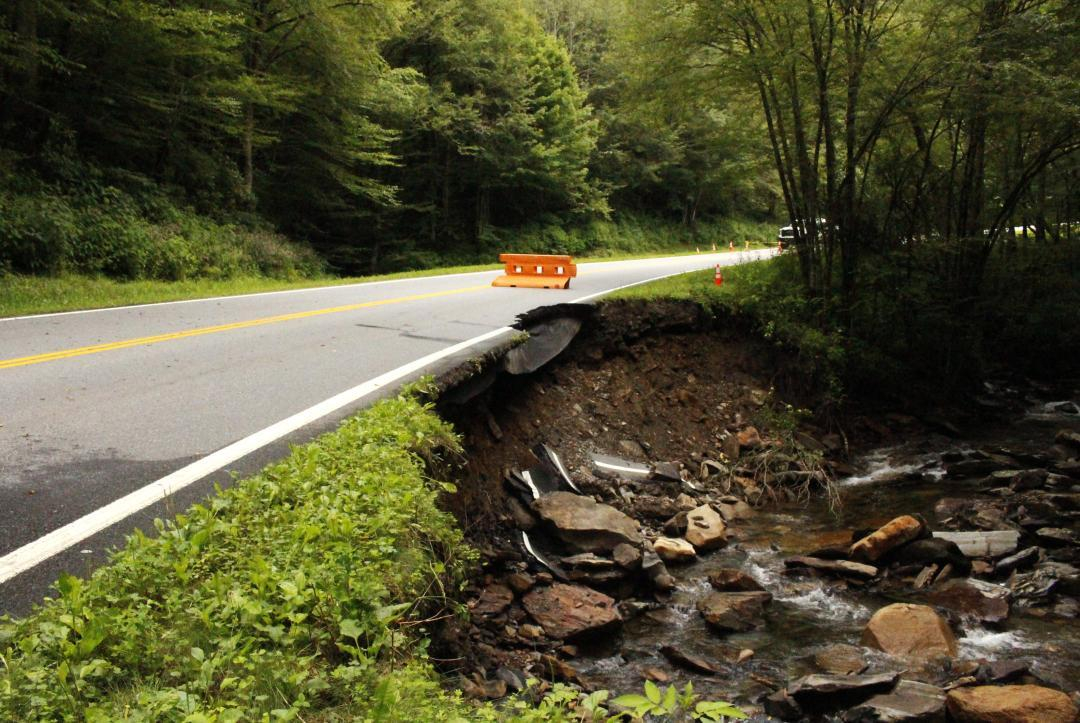Displaying items by tag: great smoky mountains national park climate change
Feds award expedited work on Newfound Gap Road after latest regional weather disaster

US 441 from Sugarlands to Newfound Gap expected to reopen by end of September after heavy rains wash out roadway
Katie Liming is a public information officer with the National Park Service.
GATLINBURG — The National Park Service and the Federal Highway Administration continue to work quickly to repair the road washout on US 441/Newfound Gap Road. The FHWA has awarded the contract to Eclipse Companies, LLC, and the NPS and FHWA held a pre-construction meeting with the contractor on Friday. The contractor was expected to begin mobilizing equipment and supplies this week.
Construction is expected to be completed on or before September 30.
The park responded Aug. 1 to reports of a road washout and landslide event on Newfound Gap Road between mile marker 12 and 13 on the Tennessee side of the park (south of Alum Cave trailhead).
The affected area spans about 125 feet and has significantly undercut nearly the entire width of the southbound lane. On August 2, NPS and FWHA engineers visited the slide and immediately began project scoping. Both agencies worked quickly to complete the required steps of the design, permitting and contracting processes for construction.
- us 441/newfound gap road
- smokies heavy rain
- us 441 closed
- can i drive through smokies
- sugarlands
- great smoky mountains national park
- great smoky mountains national park climate change
- smokies storm damage
- smokies travel conditions
- smokies news
- shuttle services in great smoky mountains national park
- smokies shuttle
Fire, fog, floods: Scientists probe climate-change impacts in Smokies
 Many climate-change related issues have appeared since publication of this vintage map of Great Smoky Mountains National Park. Library of Congress
Many climate-change related issues have appeared since publication of this vintage map of Great Smoky Mountains National Park. Library of Congress
Invasive insects are among the vanguard of noticeable climate changes in America’s most-visited national park
GATLINBURG — Ants scurry beneath the carpet of last year’s leaves in Great Smoky Mountains National Park. The native ants are busy spreading the seeds of violets and bloodroot, preparing a new carpet of spring wildflowers to draw thousands of visitors.
But the local insects aren’t alone under there. They have become prey to venomous Asian needle ants that also prowl the leaf litter.
These invaders dine on termites, other ants and insects, while stealing habitat from them. Unlike invasive fire ants, needle ants can live in pristine forests and build large colonies with hundreds of queens. But like fire ants, needle ants have a painful sting that can trigger an allergic reaction.
Climate change is expected to make it easier for invasive species like needle ants to upset the delicate balance of this temperate rainforest full of rare plants and animals. That’s just one example.
- great smoky mountains
- climate change appalachia
- southern appalachian climate change
- great smoky mountains national park climate change
- needle ant
- are ants affected by climate change
- daniel malagon
- ana barro
- jason fridley
- paul super
- ipcc
- climate precipitation change
- smokies science
- national ecological observatory network
- neon
- armadillo
- invasive species
- change in precipitation
- importance of cloud to water balance highelevation ecosystem
- biodiversity
- climate change research
- sampling plot